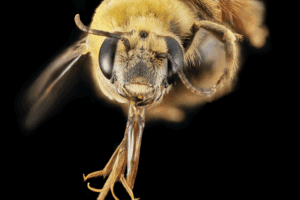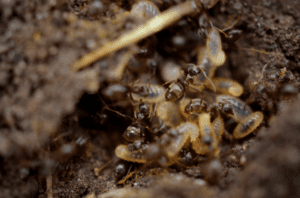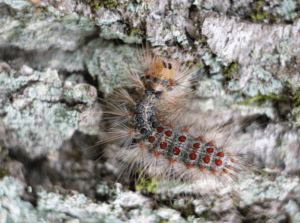
The Twin-Boro team of pest control experts and technicians, understand that the cost of keeping your property free from pests should never come at the cost of harming the environment - especially when it comes to protecting the planet's pollinators like butterflies and bees. With this in mind, we have created a guide on how to protect pollinators while managing pests. This guide has a specific focus regarding how to safely address dirt dauber activity.Dirt daubers are usually harmless and are beneficial to the environment due to their spider-hunting habits; however, their nests can become inconvenient and unsightly around homes.
In this article, we walk you through eco-friendly and highly targeted strategies you can implement to remove dirt daubers without harming the helpful insects.
What Are Dirt Daubers?
Dirt daubers, also commonly referred to as mud daubers, are quiet and solitary wasps that are recognized for their slim bodies, narrow waists and blue or metallic coloration. Some species of dirt daubers, like the blue mud dauber, have a noticeable and iridescent sheen while others like the black and yellow mud dauber, have more distinct color patterns. They are typically around ½ to 1 inch in length and also have long legs, giving them a more graceful appearance.
The greatest difference between wasps and bees is that bees are less aggressive than most wasp species. However, as opposed to more social and aggressive wasps, dirt daubers are not aggressive and rarely sting humans. As stated previously, they are actually solitary insects which means every female builds her own nest without the help of a colony. This makes their behavior more docile as they do not need to defend their nests as vigorously as other wasps. They also use their sting to paralyze prey rather than for defensive purposes.
Dirt daubers are also well-known for building small tubular nests that are made from mud. These nests are usually found on sheltered surfaces including ceilings, walls or under eaves. Each tube of mud works as a chamber where a female will lay a single egg. Once the egg hatches, the larva will feed on a paralyzed spider that is also placed in the nest. When the larva feeds on the spider, it pupates and will emerge later as an adult.
This nesting behavior is in strong contrast to that of social wasps like hornets or yellowjackets, which builds large and communal nests that they aggressively protect.
Unlike their social counterparts, dirt daubers play a beneficial role by controlling spider populations which makes them a somewhat helpful presence around homes.
Are Dirt Daubers Dangerous?
It is important to note that dirt daubers are not a significant threat to properties and humans. As they are solitary, they rarely sting even when disturbed. Unlike social wasps, they don’t defend their nests in large communal swarms which makes encounters with these insects far less dangerous. In fact, most people are able to coexist with dirt daubers without any incident.
Regarding property, the most notable issue with dirt daubers is simply cosmetic or aesthetic. Their muddy nests make for eyesores on ceilings, walls or outdoor surfaces. However, they are not structurally damaging and can be removed easily when they have been vacated.
Safe and Natural Methods to Remove Dirt Daubers
Environmentally friendly pest control solutions for removing these pests focuses on deterring their nesting behaviors without causing harm to the insects or the environment. The simplest and most effective method for dirt dauber pest control is to knock down nests in the early stages of their construction. This is because they are less likely to return to an environment where their efforts have been disrupted.
Early removal of nests also prevents mud structures from becoming hard which makes cleaning up less messy. A simple spray of water from a hose can easily dislodge nests without the need for harsh chemicals. This is incredibly useful for higher or hard-to-reach areas. We also suggest approaching the nests in the evening as the wasps will be less active.
There are other natural approaches to take. Citrus oils like lemon or orange oil repel wasps because of their scent. You can apply these oils to common nesting sports to make the spots less attractive to the insects. Other natural repellents include peppermint oil, eucalyptus oil, and vinegar sprays.
Another tip is to seal cracks and crevices to prevent dirt daubers from selecting an area as a suitable nesting site. By using these eco-friendly and DIY pest control practices, you are able to manage dirt dauber activity without resorting to harmful insecticides or disrupting the ecosystem.
How to Prevent Dirt Daubers from Rebuilding Nests
Prevention is better than cure! Preventing dirt daubers from coming back to your property involves creating an unwelcoming environment for nesting. This is where entry points come into play.
Sealing entry points is vital. Dirt daubers often enter through vents, gaps and cracks around windows or doors. So it is important to check your home’s exterior and seal off these areas with weatherproof sealant or caulk. You can also install mesh screens over utility openings or vents to prevent access to sheltered indoor spaces such as attics or garages.
Reflective objects are also known for deterring dirt daubers. Hang shiny materials or specialized reflective tape in areas that dirt daubers tend to nest. The light and movement from these objects will confuse the wasps, making the area feel unsafe for building a nest.
Cleanliness is another important element to consider. Always maintain a clean exterior and remove old nests as some wasps like to return to old nesting sites. Make sure to clean off mud residue and wash or repaint surfaces where nests have been previously built.
All of the above methods will help create a wasp-resistant zone without the use of harmful chemicals.
Avoiding Harm to Pollinators While Controlling Dirt Daubers
When it comes to controlling dirt daubers, it’s vital to ensure that pollinators such as bees and butterflies are not harmed in the process. One of the most important steps is to avoid using chemicals or insecticides in this process. These substances are harmful to dirt daubers and also create significant risk to pollinators.
Rather than taking a chemical approach, make use of targeted and non-toxic methods when it comes to dirt dauber control. For example, simply remove or wash away nests using water sprays.
Living in Harmony with Dirt Daubers and Pollinators
Managing dirt daubers effectively takes a thoughtful, eco friendly and strategic approach that is designed to address the problem without harming other insects.
These wasps are mostly non-aggressive and help control spider populations, making them more of a nuisance than a serious threat. Simple methods can prevent dirt dauber infestations without resorting to harsh chemicals.
Twin-Boro understand the importance of maintaining a pest-free home while protecting the environment. As experts in residential pest control and yard pest control, we use Integrated Pest Management (IPM) techniques to solve pest issues efficiently and safely.
Our eco-conscious methods focus on long-term prevention, targeted treatments, and the use of natural deterrents whenever possible. We care about the well-being of your family, pets, and the environment.
If you're experiencing persistent issues with dirt daubers or any other pests, contact us today for a consultation. We’re committed to delivering peace of mind with minimal impact on nature.






